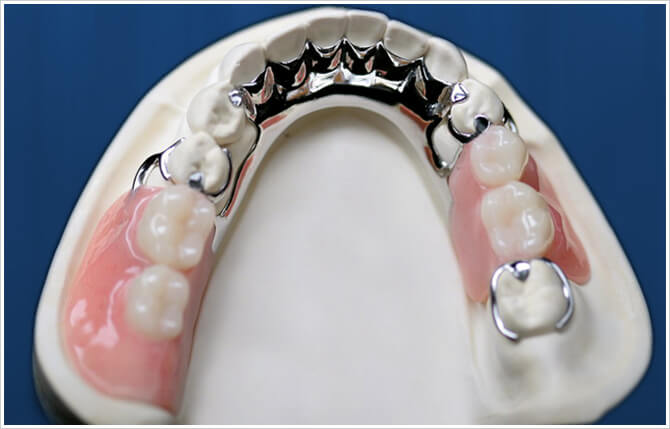CAST PARTIAL DENTURE
What is the treatment ?
A denture is a removable frame or plate used for the purpose of holding one or multiple artificial teeth, as a replacement for missing teeth in the mouth. A cast partial denture is a removable partial denture made up of a cast metal framework which houses the artificial teeth.

The teeth are usually set in an acrylic resin. Cast partial dentures are generally stronger and more durable than the usual acrylic dentures, but also more expensive and complexly formed, due to the various processes involved and amount of time required. They are designed for individual patients with specific measurements.
Cast partial dentures cause minimal tissue damage in the mouth, reduces the stress on the other teeth, prevent other teeth from shifting, have greater reliability and durability than acrylic dentures. They also require minimal direct retention in comparison to acrylics.
How is the treatment done?
Fabricating cast partial dentures involves multiple dental visits. The dentures must be uniquely designed on the basis of the dental conditions of the individual. The process begins with taking dental impressions of the upper and lower dental arches. These are used to fabricate study models for preparing the dentures. Dentists are required to perform a procedure known as mouth preparation which involves modifying and shifting some teeth in order to place and stabilise the dentures. The final mouth impressions for creating the dentures are taken only after the mouth preparation process is completed. This final impression and the first impression are used to for a final model which is used in fabricating the metal framework of the cast partial denture.
This involves work by dental technicians in dental laboratories and can be time consuming as it requires great precision. Then, the metal framework is tried and tested by the patient to check the design and accuracy. Fitting and retention are very important. There may be more adjustments to the framework according to these requirements. After the metal framework has been finalised, the dentists begin work on the bite or occlusion of the patient. This involves a process known as bite registration. The dentist also selects a shade for the dentures based on the colour of the patient’s other teeth. The artificial teeth are placed in the framework based on the bite registration.
The end result is a set of trial dentures which are tested by the patient before the casting of the final partial dentures. In the next visit, the dentures are fitted in the patient’s mouth and adjustments are made for stabilisation, fit retention, aesthetics, and occlusion. The patient also receives clear instructions about proper care of the new dentures.
Who is eligible for the treatment ? ( When is the treatment done ?)
Cast partial dentures are mainly required by aging people who have begun losing teeth, which has led to problems or discomfort in communicating or eating. In certain cases, they may also be suitable for people who have prematurely lost teeth due to medical conditions or injuries. Dentures are a substitute for the missing teeth, in order to relieve the stress upon the remaining teeth which may have been taking up excessive strains. Missing teeth would also leave gaps which would be the breeding ground for oral hygiene issues and germs. Over a period of time, this can also lead to stress upon the gums and muscles in the mouth, leading to inflammation or infections. Dentures are particularly useful in increasing the quality of life of people and allowing them to feel more confident about their appearance.
